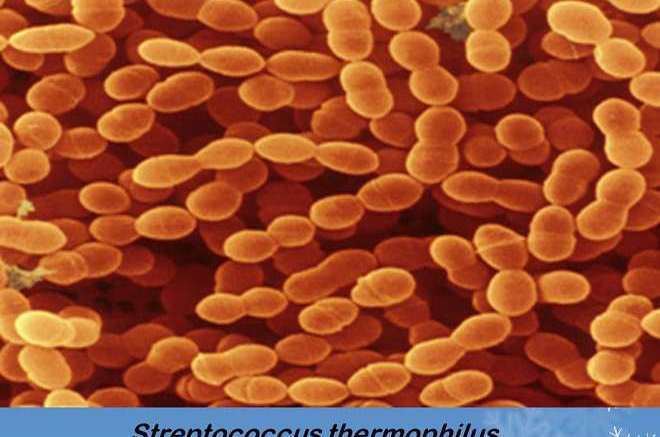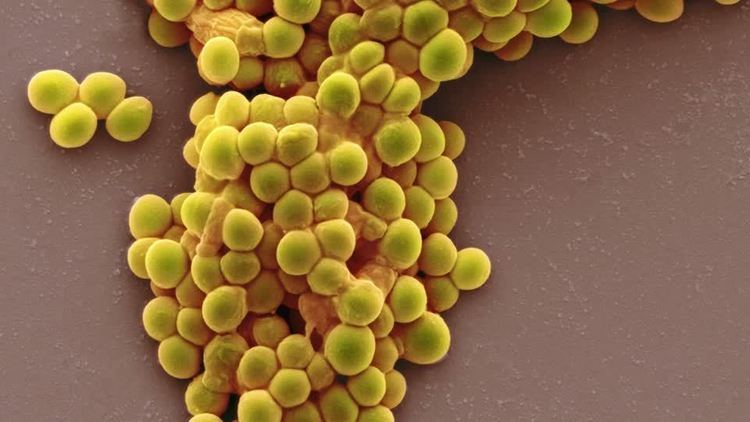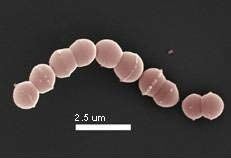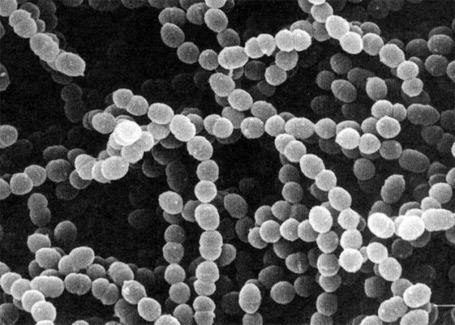Order Lactobacillales Rank Species | Higher classification Streptococcus | |
 | ||
Scientific name Streptococcus thermophilus Similar Lactobacillus delbrueckii subsp bu, Bacteria, Lactobacillus, Lactobacillus casei, Bifidobacterium | ||
Streptococcus thermophilus
Streptococcus thermophilus also known as Streptococcus salivarius subsp. thermophilus is a gram-positive bacterium, and a fermentative facultative anaerobe, of the viridans group. It tests negative for cytochrome, oxidase, and catalase, and positive for alpha-hemolytic activity. It is non-motile and does not form endospores. S. thermophilus is fimbriated. It has an optimal growth temperature range of 35 - 42 °C while L. bulgaricus has an optimal range of 43 - 46 °C.
Contents
- Streptococcus thermophilus
- Classification
- Uses
- Yogurt production
- Nomenclature
- Pathogenic potential
- Adjuvant
- Reduced fat cheese
- Cancer
- Antibiotic associated diarrhea
- Health concerns
- References

It is also classified as a lactic acid bacterium. S. thermophilus is found in fermented milk products, and is generally used in the production of yogurt, alongside Lactobacillus delbrueckii subsp. bulgaricus. The two species are synergistic, and S. thermophilus probably provides L. d. bulgaricus with folic acid and formic acid which it uses for purine synthesis.

Classification
At least 26 strains of S. thermophilis have been identified and their genomes sequenced.
Uses

S. thermophilus is one of the most widely used bacteria in the dairy industry. USDA statistics from 1998 showed that more than 1.02 billion kilograms of mozzarella cheese and 621 million kilograms of yogurt were produced from S. thermophilus. Although its genus, Streptococcus, includes some pathogenic species, food industries consider S. thermophilus a safer bacterium than many other Streptococcus species. In fact, yogurt and cheese that contain live cultures of S. thermophilus are thought to be beneficial to health. Live cultures of S. thermophilus make it easier for people who are lactose intolerant to digest dairy products. The bacteria break down lactose, the sugar in milk, that lactose-intolerant people find difficult to digest.
Yogurt production

As early as the 1900s, S. thermophilus has been used to make yogurt. Its purpose is to turn lactose, the sugar in milk, into lactic acid. The increase in lactic acid turns milk into the gel-like structure characteristic of yogurt.
Nomenclature
"Streptococcus" derives from a Greek term meaning "twisted berry" and refers to the way the bacterium is grouped in chains that resemble a string of beads. "Thermophilus" derives from the Greek thermē, meaning "heat". It refers to an organism's ability to thrive at high temperatures.
Pathogenic potential
The genus Streptococcus includes several pathogenic species, such as S. pneumoniae and S. pyogenes, but food industries consider S. thermophilus non-pathogenic. S. thermophilus is believed to have developed separately from pathogenic Streptococcus species for at least 3000 years. Research teams have sequenced the genome of two strains of S. thermophilus, CNRZ1066 and LMG13811, and stated that the bacteria are not dangerous.
Adjuvant
S. thermophilus strain Orla-Jensen 1919 is a constituent in VSL#3. This standardized, formulation of live bacteria may be used in combination with conventional therapies to treat ulcerative colitis. The use of the S. thermophilus-containing VSL#3 may reduce inflammation in mice.
Reduced-fat cheese
S. thermophilus helps make reduced-fat cheese with similar characteristics to regular, full-fat cheese. In the experiment, two different strains of bacteria are used to make reduced-fat cheddar cheese: a strain of Lactococcus lactis and a strain of S. thermophilus. These bacteria are chosen because they produce exopolysaccharide (EPS) which give reduced-fat cheese a similar texture and flavor as regular cheese. However, cheese made from L. lactis yielded a different type of cheese from S. thermophilus.
L. lactis produced cheese with higher moisture levels compared to other reduced-fat cheeses. On the other hand, S. thermophilus produced low moisture cheese and decreased the bitterness of cheese. It had been concluded that applying both L. lactis and S. thermophilus strains create higher quality reduced-fat cheese with similar characteristics to regular cheese.
Cancer
Chemotherapy often causes mucositis, severe inflammation of primarily the small intestines. Currently, there is no treatment to alleviate the symptoms of mucositis caused by chemotherapy. When rats were inflicted with mucositis by chemotherapy drugs, the intestinal tissues in those pretreated with streptococcus thermophilus TH-4 functioned more healthily and were less distressed.
In her nutrition book, Food: Your Miracle Medicine, Jean Carper describes an experiment by Joseph A. Scimeca, in which commercially available yogurt containing S. thermophilus and L. d. bulgaricus was fed to mice. After these mice were injected with cancer cells, the incidence of lung cancer in the yogurt-fed mice was one-third less than expected.
Antibiotic-associated diarrhea
Strains of S. thermophilus have also reduced risks of AAD (antibiotic-associated diarrhea), an issue that results from taking antibiotics. Antibiotics can have the adverse effect of destroying beneficial bacteria and causing harmful bacteria to multiply, which invokes diarrhea. Adults who ate yogurt containing S. thermophilus while being treated with antibiotics had lower rates of diarrhea than the control group (12.4% vs. 23.7%).
Health concerns
The manipulation of the gut flora is complex and may cause bacteria-host interactions. Although probiotics, in general, are considered safe, there are concerns about their use in certain cases. Some people, such as those with compromised immune systems, short bowel syndrome, central venous catheters, heart valve disease and premature infants, may be at higher risk for adverse events. Rarely, consumption of probiotics may cause bacteremia, and sepsis, potentially fatal infections in children with lowered immune systems or who are already critically ill.
